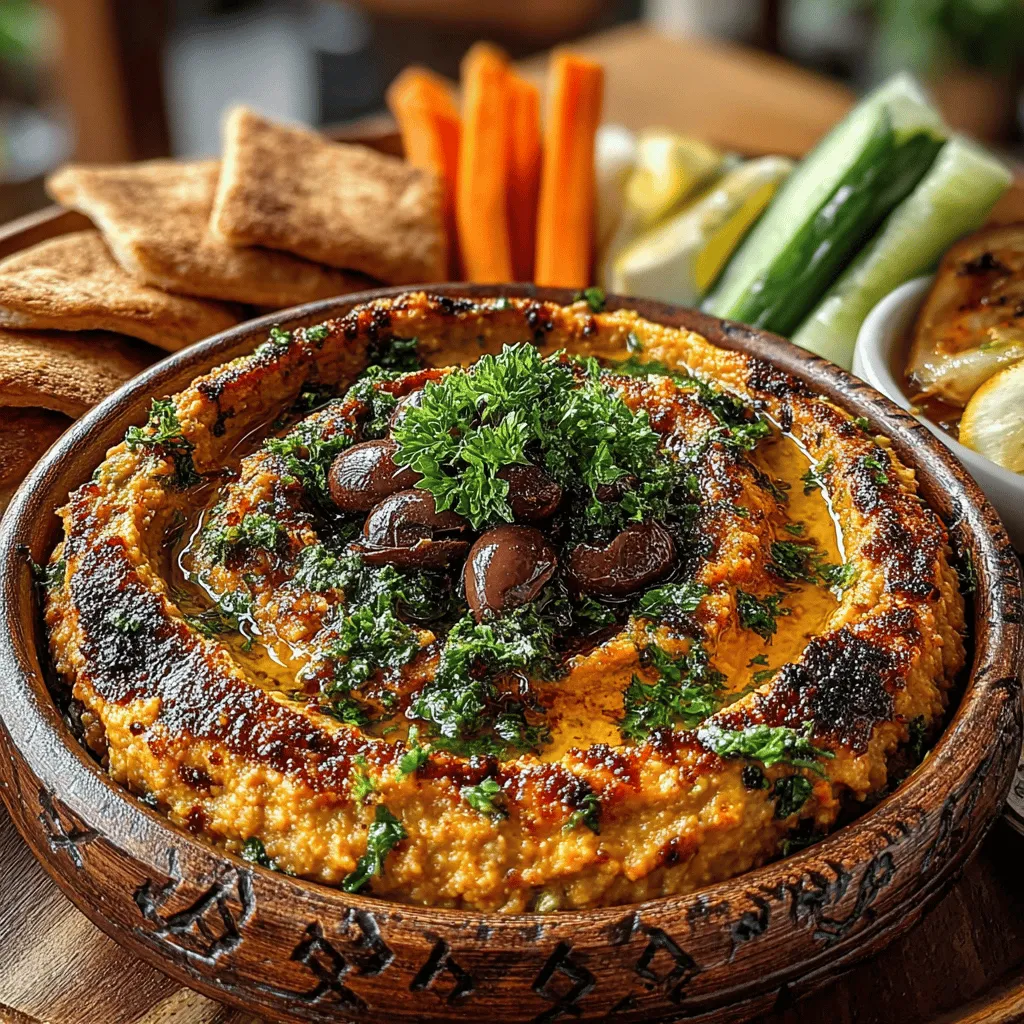Introduction to Mediterranean Delight: Roasted Eggplant & Cucumber Tapenade
Mediterranean cuisine is celebrated for its vibrant flavors, rich history, and an emphasis on fresh, wholesome ingredients. This culinary tradition spans several countries, including Greece, Italy, Spain, and Turkey, each bringing its unique flair while adhering to common principles of health and simplicity. At the heart of Mediterranean cooking lies the use of vegetables, legumes, grains, and healthy fats, particularly olive oil, which contribute to both the flavor and nutritional value of the dishes.
One exemplary recipe that encapsulates the essence of Mediterranean flavors is Roasted Eggplant & Cucumber Tapenade. This dish is not just a simple spread but a delightful fusion of roasted and fresh ingredients, creating a balanced and flavorful appetizer or snack. The tapenade is versatile enough to serve on crostini for a sophisticated gathering or as a dip for vegetables during a casual get-together. Its unique combination of flavors and textures makes it a standout choice for anyone looking to explore the delightful offerings of Mediterranean cuisine.
The ingredients in this tapenade are not only delicious but also packed with health benefits. Eggplant, the star of the dish, is low in calories and high in fiber, making it a great choice for those looking to maintain a healthy diet. Cucumber adds a refreshing crunch and is known for its hydrating properties, while olive oil provides heart-healthy fats. Together with the richness of Kalamata olives and the aromatic freshness of parsley and capers, this dish becomes a powerhouse of nutrients that can support overall health and well-being.
What sets this tapenade apart is its versatility. Whether served as a dip, a sandwich spread, or a topping for grilled meats and fish, Roasted Eggplant & Cucumber Tapenade appeals to a wide range of palates. It can be enjoyed warm or chilled, making it suitable for any occasion. As we delve into the preparation of this delightful dish, you’ll discover how easy it is to bring a taste of the Mediterranean to your table.
Understanding the Key Ingredients
Eggplant: Nutritional Benefits and Culinary Uses
Eggplant, also known as aubergine, is a staple in Mediterranean cooking. This versatile vegetable is not only visually appealing with its deep purple skin and creamy white flesh, but it also boasts a range of nutritional benefits. Rich in antioxidants, particularly nasunin, which is found in the skin, eggplant helps protect the body from oxidative stress. Additionally, it is low in calories and high in fiber, promoting digestive health and aiding in weight management. Its spongy texture allows it to absorb flavors beautifully, making it an ideal candidate for roasting in this tapenade.
Cucumber: Refreshing Flavor and Health Benefits
Cucumber is another key ingredient in this tapenade, known for its crisp texture and refreshing taste. This hydrating vegetable is composed of about 95% water, making it an excellent choice for maintaining hydration, especially in warm weather. Cucumbers are low in calories yet high in vitamins and minerals, including vitamin K, which supports bone health. They also contain antioxidants that help reduce inflammation and promote overall health. Diced cucumbers in the tapenade not only add flavor but also contribute a satisfying crunch that balances the creaminess of the roasted eggplant.
Olive Oil: Importance in Mediterranean Diet
Olive oil is often referred to as the heart of Mediterranean cuisine, and for good reason. This healthy fat is loaded with monounsaturated fatty acids, which are known to reduce the risk of heart disease. It is also rich in antioxidants and has anti-inflammatory properties. In the tapenade, olive oil not only enhances the flavor but also contributes to the smooth texture of the spread. Whether drizzled over the roasted eggplant or used as a base for blending the ingredients, quality extra virgin olive oil elevates the dish to new heights.
Kalamata Olives: Richness and Flavor Profile
Kalamata olives are a quintessential ingredient in Mediterranean cooking, known for their deep purple color and robust flavor. These olives are packed with healthy fats, fiber, and various vitamins and minerals. Their briny, slightly bitter taste adds a depth of flavor to the tapenade, balancing the sweetness of the roasted eggplant. Moreover, Kalamata olives are an excellent source of antioxidants, which can help protect against chronic diseases. Including them in the tapenade infuses the dish with authenticity and enhances its overall taste.
Fresh Parsley and Capers: Enhancing Flavors and Health Benefits
Fresh herbs play a crucial role in Mediterranean cuisine, and parsley is no exception. This vibrant herb adds a burst of freshness and color to the tapenade while providing a variety of vitamins, including vitamin C and vitamin K. Parsley is also known for its detoxifying properties and can aid in digestion. Capers, on the other hand, contribute a unique tangy flavor that brightens the dish. These small flower buds, often pickled, are low in calories and rich in antioxidants, making them a flavorful addition that complements the other ingredients beautifully.
Step-by-Step Guide to Preparing Roasted Eggplant & Cucumber Tapenade
Roasting the Eggplant
The first step in creating a flavorful Roasted Eggplant & Cucumber Tapenade is to properly roast the eggplant. Roasting not only enhances the natural sweetness of the eggplant but also adds a smoky depth to the flavor profile. To begin, select a firm, glossy eggplant, which indicates freshness. Cut the eggplant into cubes, ensuring they are uniform in size to promote even cooking.
To prepare the eggplant for roasting, it is essential to draw out excess moisture and bitterness. Place the cubed eggplant in a colander and sprinkle it generously with salt. Allow it to sit for about 30 minutes; this process, known as sweating, helps to remove unwanted bitterness and moisture. After 30 minutes, rinse the eggplant under cold water and pat it dry with paper towels.
Next, preheat your oven to 400°F (200°C). Line a baking sheet with parchment paper for easy cleanup. Toss the eggplant cubes with a generous drizzle of olive oil, ensuring they are well-coated. Spread the cubes in a single layer on the baking sheet to ensure they roast evenly. Roast the eggplant in the preheated oven for about 25 to 30 minutes, or until they are golden brown and tender, flipping them halfway through to promote even browning.
Importance of Proper Roasting for Flavor Development
Achieving perfectly roasted eggplant is crucial for developing the rich, complex flavors that make this tapenade exceptional. The caramelization that occurs during roasting intensifies the natural sweetness of the eggplant, while the high heat enhances the overall flavor profile. Avoid overcrowding the baking sheet, as this can lead to steaming rather than roasting, resulting in a less desirable texture and flavor.
Detailed Instructions for Preparing and Roasting Eggplant
1. Select and Cut: Choose a fresh eggplant and cut it into uniform cubes.
2. Sweat the Eggplant: Place the cubes in a colander, sprinkle with salt, and let sit for 30 minutes. Rinse and pat dry.
3. Preheat Oven: Set your oven to 400°F (200°C).
4. Coat with Olive Oil: Toss the dried eggplant with olive oil.
5. Roast: Spread the cubes on a lined baking sheet and roast for 25 to 30 minutes, flipping halfway through.
Tips for Achieving Perfectly Roasted Eggplant
– Choose smaller eggplants, as they tend to be sweeter and less bitter than larger ones.
– Use a high-quality olive oil for the best flavor.
– Ensure even spacing of the eggplant cubes on the baking sheet to prevent steaming.
– Keep an eye on the eggplant towards the end of the roasting time to avoid burning.
Preparing the Cucumber
While the eggplant is roasting, it’s time to prepare the cucumber. The freshness of the cucumber is essential in this tapenade, providing a contrast to the warm, roasted eggplant. Start by selecting firm, unblemished cucumbers, preferably organic if available.
To prepare the cucumber, wash it thoroughly under cold water to remove any dirt or pesticides. Next, cut off both ends of the cucumber and slice it in half lengthwise. Using a small spoon, scoop out the seeds if desired, as this can help reduce excess moisture in the tapenade. After removing the seeds, cut the cucumber into small dice, aiming for pieces that are roughly the same size for uniform texture in the final dish.
Techniques for Dicing and Preparing Cucumber
1. Wash: Rinse the cucumber under cold water.
2. Remove Ends: Cut off both ends of the cucumber.
3. Halve and Seed: Slice in half lengthwise and scoop out the seeds if desired.
4. Dice: Cut the cucumber into small, uniform cubes.
Importance of Texture in the Tapenade
The texture of the cucumber is key in achieving a balanced tapenade. Diced cucumbers provide a satisfying crunch that contrasts with the creaminess of the roasted eggplant, creating a delightful mouthfeel. Be sure to pat the diced cucumber dry with paper towels to remove excess moisture, preventing the tapenade from becoming watery.
In this first part of our exploration of Roasted Eggplant & Cucumber Tapenade, we have delved into the vibrant world of Mediterranean cuisine, highlighted the health benefits of each ingredient, and started the preparation process. The next steps will guide you through combining these flavorful components into a delicious and versatile tapenade that is sure to impress your family and friends.

Combining Ingredients for Maximum Flavor
Once your roasted eggplant and cucumbers have cooled, it’s time to combine them with the other ingredients to create a delicious tapenade. This dish celebrates the vibrant flavors of the Mediterranean, and each component plays a crucial role in achieving the perfect balance.
Detailed Steps for Mixing the Ingredients
1. Prepare the Base: In a large mixing bowl, combine the cooled roasted eggplant and diced cucumbers. Ensure that the eggplant is well-drained to avoid excess moisture in the tapenade.
2. Add Aromatics: Next, finely chop the garlic cloves and add them to the bowl. Garlic not only provides a robust flavor but also contributes to the overall aroma of the dish.
3. Incorporate Olives: Chop the Kalamata olives roughly, ensuring they are a manageable size for spreading. Add them to the eggplant and cucumber mixture. The briny flavor of the olives is essential for that authentic Mediterranean taste.
4. Mix in Fresh Herbs: Finely chop fresh parsley, basil, and mint, and fold them into the mixture. These herbs will enhance the freshness of the tapenade and add layers of flavor.
5. Add Olive Oil and Lemon Juice: Drizzle in high-quality extra virgin olive oil and freshly squeezed lemon juice. Use about three tablespoons of olive oil and the juice of one lemon, adjusting to taste.
6. Season Generously: Finally, sprinkle sea salt and freshly cracked black pepper over the mixture. Start with a teaspoon of salt and half a teaspoon of pepper, and adjust once you’ve mixed everything together.
7. Toss Gently: Use a spatula or spoon to mix all the ingredients gently, ensuring everything is well combined without mashing the eggplant and cucumbers too much. Taste and adjust the seasoning as necessary.
Balancing Flavors: The Role of Olive Oil, Garlic, and Lemon Juice
Each of these ingredients plays a pivotal role in balancing the overall flavor profile of the tapenade. The olive oil adds richness and a silky texture, while the garlic introduces a robust, aromatic quality. The lemon juice not only brings brightness, cutting through the richness, but also enhances the freshness of the vegetables. Together, they create a harmonious blend that enhances the natural flavors of the eggplant and cucumbers.
Importance of Seasoning with Salt and Pepper
Seasoning is critical to ensuring that each bite of the tapenade is flavorful. Salt helps to enhance the taste of the ingredients, while pepper adds a subtle warmth. It’s essential to taste as you go, allowing you to find the perfect balance that suits your palate. Remember, you can always add more, but it’s challenging to correct an overly salted dish.
Chilling the Tapenade
Explanation of Flavor Development during Chilling
After mixing all the ingredients, it’s important to let the tapenade chill in the refrigerator. Chilling allows the flavors to meld and develop, resulting in a more cohesive and delicious dish. The cold temperature helps to intensify the flavors, making each bite more enjoyable.
Timing Recommendations for Best Results
For optimal flavor development, allow the tapenade to chill for at least 30 minutes, although a few hours or even overnight is ideal. If time permits, preparing the tapenade a day in advance can yield superior results, giving the garlic and herbs time to infuse their flavors into the eggplant and cucumbers.
Serving Suggestions for Roasted Eggplant & Cucumber Tapenade
Exploring Different Serving Options
The versatility of this roasted eggplant and cucumber tapenade makes it an excellent addition to various dishes. It can be served as an appetizer, condiment, or even as a side dish alongside a Mediterranean feast.
Complementing the Tapenade with Toasted Pita Chips
One of the best ways to enjoy this tapenade is with toasted pita chips. Simply cut pita bread into triangles, brush them lightly with olive oil, and bake them at 375°F (190°C) for about 10-12 minutes or until golden brown. The crunchy texture of the pita chips pairs beautifully with the creamy tapenade, creating a delightful contrast.
Alternative Suggestions: Fresh Vegetable Sticks
For a healthier option, serve the tapenade alongside fresh vegetable sticks such as carrots, celery, and bell peppers. This not only adds color to your presentation but also boosts the nutritional value of your dish. Guests can dip the crunchy veggies into the tapenade for a refreshing and healthy snack.
Presentation Ideas: Making it Visually Appealing
To elevate your serving presentation, consider using a shallow bowl or a wooden serving board. Arrange the pita chips or vegetable sticks around the tapenade, and garnish the top with a drizzle of olive oil and a sprinkle of fresh herbs. This not only looks inviting but also encourages guests to dig in.
Nutritional Analysis of the Tapenade
Breakdown of Nutritional Benefits per Serving
This roasted eggplant and cucumber tapenade is not only delicious but also packed with nutritional benefits. Each serving is low in calories yet high in essential nutrients. Eggplant is rich in antioxidants, particularly nasunin, which helps protect brain health. Cucumbers are hydrating and low in calories, making them an excellent choice for weight management.
How this Recipe Fits into a Healthy Diet
The use of whole, fresh ingredients means that this tapenade is a nutrient-dense option for those looking to incorporate more vegetables into their diet. The healthy fats from olive oil contribute to heart health, while the herbs add vitamins and minerals. This dish fits well into a balanced diet, providing a good mix of carbohydrates, healthy fats, and fiber.
The Tapenade’s Role in a Balanced Mediterranean Diet
Incorporating this tapenade into your meals aligns perfectly with the principles of a Mediterranean diet, which emphasizes whole foods, healthy fats, and fresh vegetables. It can be enjoyed as part of a larger spread that includes whole grains, lean proteins, and an abundance of fruits and vegetables, promoting overall health and wellness.
Conclusion: The Joy of Mediterranean Tapenade
In summary, this roasted eggplant and cucumber tapenade is a delightful addition to any table. It captures the essence of Mediterranean cuisine with its fresh ingredients and bold flavors. The process of combining and chilling the ingredients not only enhances the taste but also allows for a convenient make-ahead option for gatherings and meals.
Reflecting on the cultural significance of tapenade, it’s clear that this dish is more than just a recipe; it embodies the communal spirit of Mediterranean dining. Sharing food is a cherished tradition in this region, and this tapenade is a perfect example of how simple ingredients can come together to create something truly special.
As you savor this tapenade, consider exploring more Mediterranean recipes. The vibrant flavors and healthful ingredients of this cuisine offer countless opportunities to delight your senses and nourish your body. Enjoy the journey into the world of Mediterranean cooking, one delicious dish at a time.


